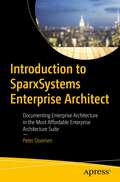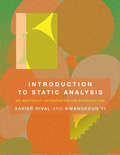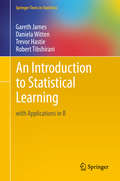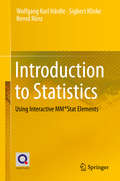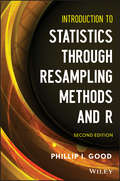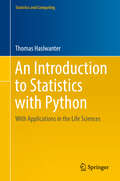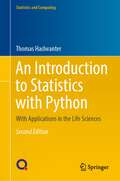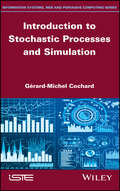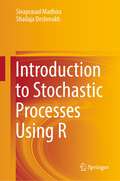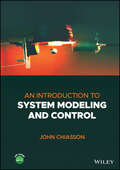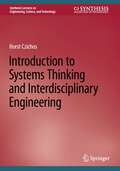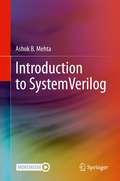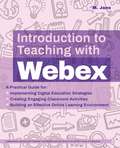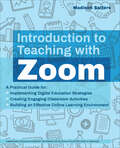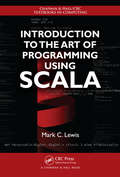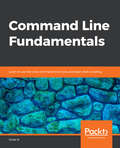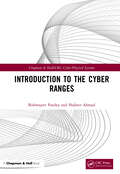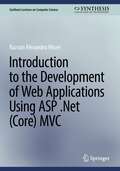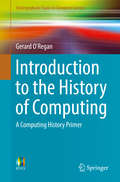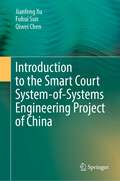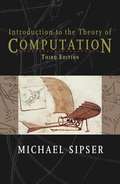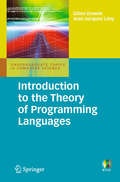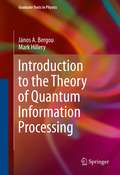- Table View
- List View
Introduction to SparxSystems Enterprise Architect: Documenting Enterprise Architecture in the Most Affordable Enterprise Architecture Suite
by Peter DoomenSparxSystems Enterprise Architect (EA) is a logical choice for many companies and organizations: it combines a broad feature set with an affordable price. However, the robust range of features makes starting to use this fantastic tool a bit intimidating. Enter Michael, a fictional consultant and experienced enterprise architect featured throughout the book to show you how to populate a model with elements and connectors, and how to create diagrams that speak to the audience: management, project managers, internal audit, business stakeholders and IT representatives. As the book progresses Michael's duties continue with more advanced topics including the use of workflow tools such as Kanban boards. You'll even see how to present directly from Enterprise Architect so that latest information can be shown straight from the source! The last days of Michael’s mission are devoted to fine-tuning the enterprise architecture model with the help of tagged values. And to leave the model in the hands of the customer by creating a custom toolbox. What You'll Learn Setup EA and populate a model with elements, connectors and diagramsReview the Big Five of enterprise architect: Model, Packages, Diagrams, Elements, ConnectorsImplement evidence-based best practice strategies aligned with overall goalsWho This Book Is ForNon-technical users who use EA mainly to document entire landscapes.
Introduction to Static Analysis: An Abstract Interpretation Perspective
by Xavier Rival Kwangkeun YiA self-contained introduction to abstract interpretation–based static analysis, an essential resource for students, developers, and users.Static program analysis, or static analysis, aims to discover semantic properties of programs without running them. It plays an important role in all phases of development, including verification of specifications and programs, the synthesis of optimized code, and the refactoring and maintenance of software applications. This book offers a self-contained introduction to static analysis, covering the basics of both theoretical foundations and practical considerations in the use of static analysis tools. By offering a quick and comprehensive introduction for nonspecialists, the book fills a notable gap in the literature, which until now has consisted largely of scientific articles on advanced topics.The text covers the mathematical foundations of static analysis, including semantics, semantic abstraction, and computation of program invariants; more advanced notions and techniques, including techniques for enhancing the cost-accuracy balance of analysis and abstractions for advanced programming features and answering a wide range of semantic questions; and techniques for implementing and using static analysis tools. It begins with background information and an intuitive and informal introduction to the main static analysis principles and techniques. It then formalizes the scientific foundations of program analysis techniques, considers practical aspects of implementation, and presents more advanced applications. The book can be used as a textbook in advanced undergraduate and graduate courses in static analysis and program verification, and as a reference for users, developers, and experts.
An Introduction to Statistical Learning: with Applications in R (Springer Texts in Statistics #103)
by Trevor Hastie Gareth James Robert Tibshirani Daniela WittenAn Introduction to Statistical Learning provides an accessible overview of the field of statistical learning, an essential toolset for making sense of the vast and complex data sets that have emerged in fields ranging from biology to finance to marketing to astrophysics in the past twenty years. This book presents some of the most important modeling and prediction techniques, along with relevant applications. Topics include linear regression, classification, resampling methods, shrinkage approaches, tree-based methods, support vector machines, clustering, and more. Color graphics and real-world examples are used to illustrate the methods presented. Since the goal of this textbook is to facilitate the use of these statistical learning techniques by practitioners in science, industry, and other fields, each chapter contains a tutorial on implementing the analyses and methods presented in R, an extremely popular open source statistical software platform. Two of the authors co-wrote The Elements of Statistical Learning (Hastie, Tibshirani and Friedman, 2nd edition 2009), a popular reference book for statistics and machine learning researchers. An Introduction to Statistical Learning covers many of the same topics, but at a level accessible to a much broader audience. This book is targeted at statisticians and non-statisticians alike who wish to use cutting-edge statistical learning techniques to analyze their data. The text assumes only a previous course in linear regression and no knowledge of matrix algebra.
Introduction to Statistics: Using Interactive MM*Stat Elements
by Wolfgang Karl Härdle Sigbert Klinke Bernd RönzThis book covers all the topics found in introductory descriptive statistics courses, including simple linear regression and time series analysis, the fundamentals of inferential statistics (probability theory, random sampling and estimation theory), and inferential statistics itself (confidence intervals, testing).Each chapter starts with the necessary theoretical background, which is followed by a variety of examples. The core examples are based on the content of the respective chapter, while the advanced examples, designed to deepen students’ knowledge, also draw on information and material from previous chapters.The enhanced online version helps students grasp the complexity and the practical relevance of statistical analysis through interactive examples and is suitable for undergraduate and graduate students taking their first statistics courses, as well as for undergraduate students in non-mathematical fields, e.g. economics, the social sciences etc.
Introduction to Statistics Through Resampling Methods and R
by Phillip I. GoodA highly accessible alternative approach to basic statistics Praise for the First Edition: "Certainly one of the most impressive little paperback 200-page introductory statistics books that I will ever see . . . it would make a good nightstand book for every statistician."--Technometrics Written in a highly accessible style, Introduction to Statistics through Resampling Methods and R, Second Edition guides students in the understanding of descriptive statistics, estimation, hypothesis testing, and model building. The book emphasizes the discovery method, enabling readers to ascertain solutions on their own rather than simply copy answers or apply a formula by rote. The Second Edition utilizes the R programming language to simplify tedious computations, illustrate new concepts, and assist readers in completing exercises. The text facilitates quick learning through the use of: More than 250 exercises--with selected "hints"--scattered throughout to stimulate readers' thinking and to actively engage them in applying their newfound skills An increased focus on why a method is introduced Multiple explanations of basic concepts Real-life applications in a variety of disciplines Dozens of thought-provoking, problem-solving questions in the final chapter to assist readers in applying statistics to real-life applications Introduction to Statistics through Resampling Methods and R, Second Edition is an excellent resource for students and practitioners in the fields of agriculture, astrophysics, bacteriology, biology, botany, business, climatology, clinical trials, economics, education, epidemiology, genetics, geology, growth processes, hospital administration, law, manufacturing, marketing, medicine, mycology, physics, political science, psychology, social welfare, sports, and toxicology who want to master and learn to apply statistical methods.
An Introduction to Statistics with Python: With Applications in the Life Sciences (Statistics and Computing)
by Thomas HaslwanterThis textbook provides anintroduction to the free software Python and its use for statistical dataanalysis. It covers common statistical tests for continuous, discrete andcategorical data, as well as linear regression analysis and topics from survivalanalysis and Bayesian statistics. Working code and data for Python solutionsfor each test, together with easy-to-follow Python examples, can be reproducedby the reader and reinforce their immediate understanding of the topic. Withrecent advances in the Python ecosystem, Python has become a popular languagefor scientific computing, offering a powerful environment for statistical dataanalysis and an interesting alternative to R. The book is intended for masterand PhD students, mainly from the life and medical sciences, with a basicknowledge of statistics. As it also provides some statistics background, thebook can be used by anyone who wants to perform a statistical dataanalysis.
An Introduction to Statistics with Python: With Applications in the Life Sciences (Statistics and Computing)
by Thomas HaslwanterNow in its second edition, this textbook provides an introduction to Python and its use for statistical data analysis. It covers common statistical tests for continuous, discrete and categorical data, as well as linear regression analysis and topics from survival analysis and Bayesian statistics.For this new edition, the introductory chapters on Python, data input and visualization have been reworked and updated. The chapter on experimental design has been expanded, and programs for the determination of confidence intervals commonly used in quality control have been introduced. The book also features a new chapter on finding patterns in data, including time series. A new appendix describes useful programming tools, such as testing tools, code repositories, and GUIs.The provided working code for Python solutions, together with easy-to-follow examples, will reinforce the reader’s immediate understanding of the topic. Accompanying data sets and Python programs are also available online. With recent advances in the Python ecosystem, Python has become a popular language for scientific computing, offering a powerful environment for statistical data analysis.With examples drawn mainly from the life and medical sciences, this book is intended primarily for masters and PhD students. As it provides the required statistics background, the book can also be used by anyone who wants to perform a statistical data analysis.
Introduction to Stochastic Processes and Simulation
by Gerard-Michel CochardMastering chance has, for a long time, been a preoccupation of mathematical research. Today, we possess a predictive approach to the evolution of systems based on the theory of probabilities. Even so, uncovering this subject is sometimes complex, because it necessitates a good knowledge of the underlying mathematics. This book offers an introduction to the processes linked to the fluctuations in chance and the use of numerical methods to approach solutions that are difficult to obtain through an analytical approach. It takes classic examples of inventory and queueing management, and addresses more diverse subjects such as equipment reliability, genetics, population dynamics, physics and even market finance. It is addressed to those at Master's level, at university, engineering school or management school, but also to an audience of those in continuing education, in order that they may discover the vast field of decision support.
Introduction to Stochastic Processes Using R
by Sivaprasad Madhira Shailaja DeshmukhThis textbook presents some basic stochastic processes, mainly Markov processes. It begins with a brief introduction to the framework of stochastic processes followed by the thorough discussion on Markov chains, which is the simplest and the most important class of stochastic processes. The book then elaborates the theory of Markov chains in detail including classification of states, the first passage distribution, the concept of periodicity and the limiting behaviour of a Markov chain in terms of associated stationary and long run distributions. The book first illustrates the theory for some typical Markov chains, such as random walk, gambler's ruin problem, Ehrenfest model and Bienayme-Galton-Watson branching process; and then extends the discussion when time parameter is continuous. It presents some important examples of a continuous time Markov chain, which include Poisson process, birth process, death process, birth and death processes and their variations. These processes play a fundamental role in the theory and applications in queuing and inventory models, population growth, epidemiology and engineering systems. The book studies in detail the Poisson process, which is the most frequently applied stochastic process in a variety of fields, with its extension to a renewal process. The book also presents important basic concepts on Brownian motion process, a stochastic process of historic importance. It covers its few extensions and variations, such as Brownian bridge, geometric Brownian motion process, which have applications in finance, stock markets, inventory etc. The book is designed primarily to serve as a textbook for a one semester introductory course in stochastic processes, in a post-graduate program, such as Statistics, Mathematics, Data Science and Finance. It can also be used for relevant courses in other disciplines. Additionally, it provides sufficient background material for studying inference in stochastic processes. The book thus fulfils the need of a concise but clear and student-friendly introduction to various types of stochastic processes.
An Introduction to Support Vector Machines: and other kernel-based learning methods
by Nello Cristianini John Shawe-TaylorThis is the first comprehensive introduction to Support Vector Machines (SVMs), a new generation learning system based on recent advances in statistical learning theory. Students will find the book both stimulating and accessible, while practitioners will be guided smoothly through the material required for a good grasp of the theory and its applications. The concepts are introduced gradually in accessible and self-contained stages, while the presentation is rigorous and thorough. Pointers to relevant literature and web sites containing software make it an ideal starting point for further study.
An Introduction to System Modeling and Control
by John ChiassonA practical and straightforward exploration of the basic tools for the modeling, analysis, and design of control systems In An Introduction to System Modeling and Control, Dr. Chiasson delivers an accessible and intuitive guide to understanding modeling and control for students in electrical, mechanical, and aerospace/aeronautical engineering. The book begins with an introduction to the need for control by describing how an aircraft flies complete with figures illustrating roll, pitch, and yaw control using its ailerons, elevators, and rudder, respectively. The book moves on to rigid body dynamics about a single axis (gears, cart rolling down an incline) and then to modeling DC motors, DC tachometers, and optical encoders. Using the transfer function representation of these dynamic models, PID controllers are introduced as an effective way to track step inputs and reject constant disturbances. It is further shown how any transfer function model can be stabilized using output pole placement and on how two-degree of freedom controllers can be used to eliminate overshoot in step responses. Bode and Nyquist theory are then presented with an emphasis on how they give a quantitative insight into a control system's robustness and sensitivity. An Introduction to System Modeling and Control closes with chapters on modeling an inverted pendulum and a magnetic levitation system, trajectory tracking control using state feedback, and state estimation. In addition the book offers: A complete set of MATLAB/SIMULINK files for examples and problems included in the book. A set of lecture slides for each chapter. A solutions manual with recommended problems to assign. An analysis of the robustness and sensitivity of four different controller designs for an inverted pendulum (cart-pole). Perfect for electrical, mechanical, and aerospace/aeronautical engineering students, An Introduction to System Modeling and Control will also be an invaluable addition to the libraries of practicing engineers.
Introduction to Systems Thinking and Interdisciplinary Engineering (Synthesis Lectures on Engineering, Science, and Technology)
by Horst CzichosThis concise textbook introduces a systems approach to technology, describing tribological, mechatronic, cyber-physical systems, and the technologic concept of Industry 4.0 to students in a range of engineering domains. “Technology” in this book refers to the totality of human-made, benefit-oriented products, based on engineered combinations of material, energy and information. Dr. Czichos examines technology in this volume in the context of systems thinking with regard to the following main technology areasTechnical systems with “interacting surfaces in relative motion” especially in mechanical engineering, production, and transport; including the analysis of friction-induced energy losses and wear-induced materials dissipation. Technical systems that require a combination of mechanics, electronics, controls, and computer engineering for needs of industry and society. Technical systems with a combination of mechatronics and internet communication. Cyber-physical Systems for the digitalization of Industry in the development project Industry 4.0.Considers technology as combination of the physical world and the digital virtual world of information and communication.Describes the product cycle of technical systems and the corner stones of technology: material, energy and information.Presents a holistic view of technology and engineering.
Introduction to SystemVerilog
by Ashok B. MehtaThis book provides a hands-on, application-oriented guide to the entire IEEE standard 1800 SystemVerilog language. Readers will benefit from the step-by-step approach to learning the language and methodology nuances, which will enable them to design and verify complex ASIC/SoC and CPU chips. The author covers the entire spectrum of the language, including random constraints, SystemVerilog Assertions, Functional Coverage, Class, checkers, interfaces, and Data Types, among other features of the language. Written by an experienced, professional end-user of ASIC/SoC/CPU and FPGA designs, this book explains each concept with easy to understand examples, simulation logs and applications derived from real projects. Readers will be empowered to tackle the complex task of multi-million gate ASIC designs.Provides comprehensive coverage of the entire IEEE standard SystemVerilog language;Covers important topics such as constrained random verification, SystemVerilog Class, Assertions, Functional coverage, data types, checkers, interfaces, processes and procedures, among other language features;Uses easy to understand examples and simulation logs; examples are simulatable and will be provided online;Written by an experienced, professional end-user of ASIC/SoC/CPU and FPGA designs.This is quite a comprehensive work. It must have taken a long time to write it. I really like that the author has taken apart each of the SystemVerilog constructs and talks about them in great detail, including example code and simulation logs. For example, there is a chapter dedicated to arrays, and another dedicated to queues - that is great to have! The Language Reference Manual (LRM) is quite dense and difficult to use as a text for learning the language. This book explains semantics at a level of detail that is not possible in an LRM. This is the strength of the book. This will be an excellent book for novice users and as a handy reference for experienced programmers. Mark GlasserCerebras Systems
Introduction to Teaching with Webex
by M. JaneLearn to take your classroom curriculum digital using Cisco Webex&’s unique video conferencing features to create engaging lessons, collaborative activities, and more. Introduction to Teaching with Webex will help teachers of all grade levels master the basics of communication and education using the Cisco Webex video conferencing service. Learn how to connect with students, record your Webex meetings, control access to lessons, contribute to live chat streams, and conduct webinars. Webex newbie? No worries! Experienced educator and author M. Jane takes readers step-by-step through the most common Webex features and terminology. Packed with tips, tricks, troubleshooting, helpful screenshots, and activity ideas to keep students of all ages engaged, this book is indispensable as the future of teaching continues to evolve.
Introduction to Teaching with Zoom
by Madison SaltersLearn how to take your classroom curriculum digital using Zoom&’s unique video conferencing features to connect with students with amazing results. Introduction to Teaching with Zoom will help teachers of all grade levels master the basics of communication and education using the Zoom video conferencing service. With step-by-step instructions paired with helpful screenshots, teachers will learn how to connect with students, record your Zoom meetings, control access to lessons, contribute to live chat streams, and conduct webinars. Zoom newbie? No worries! Experienced educator and author Madison Salters takes readers through the most common Zoom features and terminology. Now more than ever, schools have become increasingly reliant on digital means for education. Whether public grade schools have been temporarily closed, or colleges and universities are looking to invest in distance learning, teachers need to be armed and ready to do what they do best no matter the platform. Packed with tips, tricks, troubleshooting, and lesson plans to keep students of all ages engaged, this book is indispensable as the future of teaching continues to evolve.
Introduction to the Art of Programming Using Scala (Chapman And Hall/crc Textbooks In Computing Ser.)
by Mark C. LewisWith its flexibility for programming both small and large projects, Scala is an ideal language for teaching beginning programming. Yet there are no textbooks on Scala currently available for the CS1/CS2 levels. Introduction to the Art of Programming Using Scala presents many concepts from CS1 and CS2 using a modern, JVM-based language that works we
Introduction to the Command Line
by Vivek NagarajanIntroduction to the Command Line is designed for programmers, who use GUIs, but want to understand how to use the command line to complete tasks faster and get more out of their computer. All you need for this book is basic understanding of how to use a computer.
Introduction to the Cyber Ranges (Chapman & Hall/CRC Cyber-Physical Systems)
by Bishwajeet Pandey Shabeer AhmadIntroduction to the Cyber Ranges provides a comprehensive, integrative, easy-to-comprehend overview of different aspects involved in the cybersecurity arena. It expands on various concepts like cyber situational awareness, simulation and emulation environments, and cybersecurity exercises. It also focuses on detailed analysis and the comparison of various existing cyber ranges in military, academic, and commercial sectors. It highlights every crucial aspect necessary for developing a deeper insight about the working of the cyber ranges, their architectural design, and their need in the market. It conveys how cyber ranges are complex and effective tools in dealing with advanced cyber threats and attacks. Enhancing the network defenses, resilience, and efficiency of different components of critical infrastructures is the principal objective of cyber ranges. Cyber ranges provide simulations of possible cyberattacks and training on how to thwart such attacks. They are widely used in urban enterprise sectors because they present a sturdy and secure setting for hands-on cyber skills training, advanced cybersecurity education, security testing/training, and certification. Features: A comprehensive guide to understanding the complexities involved with cyber ranges and other cybersecurity aspects Substantial theoretical knowhow on cyber ranges, their architectural design, along with case studies of existing cyber ranges in leading urban sectors like military, academic, and commercial Elucidates the defensive technologies used by various cyber ranges in enhancing the security setups of private and government organizations Information organized in an accessible format for students (in engineering, computer science, and information management), professionals, researchers, and scientists working in the fields of IT, cybersecurity, distributed systems, and computer networks
Introduction to the Development of Web Applications Using ASP .Net (Synthesis Lectures on Computer Science)
by Razvan Alexandru MezeiThis book introduces a simplified approach to web application development using the open-source ASP .Net Core MVC framework. Readers will learn to implement web applications using the following languages and frameworks: HTML, JavaScript, CSS, Bootstrap, C#, ASP .Net, and Entity Framework Core. In addition, this book addresses how to build a web application to create user accounts, store data in a database, manipulate data, and how to allow controlled access to certain parts of the application functionality. The author also covers both client-side and server-side development and the use of an object relational mapper to work with persistent data (using a database). Topics include: models, views, controllers, routing, entity framework core, identity, layouts, dependency injection and services, model binder, among others. This book: Introduces the development of web applications using the open-source ASP .Net Core MVC frameworkImplements web applications including HTML, JavaScript, CSS, Bootstrap, C#, ASP .Net, and Entity Framework CoreFeatures client-side development, server-side development, and object relational mapper software
Introduction to the History of Computing
by Gerard O'ReganTracing the story of computing from Babyloniancounting boards to smartphones, this inspiring textbook provides a conciseoverview of the key events in the history of computing, together withdiscussion exercises to stimulate deeper investigation into this fascinatingarea. Features: provides chapter introductions, summaries, key topics, and reviewquestions; includes an introduction to analogue and digital computers, and to thefoundations of computing; examines the contributions of ancient civilisationsto the field of computing; covers the first digital computers, and the earliestcommercial computers, mainframes and minicomputers; describes the earlydevelopment of the integrated circuit and the microprocessor; reviews theemergence of home computers; discusses the creation of the Internet, theinvention of the smartphone, and the rise of social media; presents a shorthistory of telecommunications, programming languages, operating systems,software engineering, artificial intelligence, and databases.
Introduction to the Senses
by Terry R.J. BossomaierAn understanding of the senses - vision, hearing, touch, chemical and other non-human senses - is important not only for many fields of biology but also in applied areas such as human computer interaction, robotics and computer games. Using information theory as a unifying framework, this is a wide-ranging survey of sensory systems, covering all known senses. The book draws on three unifying principles to examine senses: the Nyquist sampling theorem; Shannon's information theory; and the creation of different streams of information to subserve different tasks. This framework is used to discuss the fascinating role of sensory adaptation in the context of environment and lifestyle. Providing a fundamental grounding in sensory perception, the book then demonstrates how this knowledge can be applied to the design of human-computer interfaces and virtual environments. It is an ideal resource for both graduate and undergraduate students of biology, engineering (robotics) and computer science.
Introduction to the Smart Court System-of-Systems Engineering Project of China
by Jianfeng Xu Fuhui Sun Qiwei ChenThis book discusses the overall development and use of smart courts from the perspective of system-of-systems engineering (SoSE) and its methodology, analyzes the relationships between the components, structures, environments, and functions of various systems, and illustrates the basic approaches to system design, specification, integration, operation and management. As the general introductory book of the China Smart Court Development Series, this book provides an overview of the development of Chinese people's courts in the application of information technology over the past two decades and outlines the key areas of exploration in the Smart Court SoSe project centered on the development practices during the 13th Five-Year Plan period. It also forecasts the future development and evolution of the smart court information system. The key topics introduced in the book, including the overall design of complex information systems, integrated interconnection networks-based system integration, judicial big data quality control and analytics services, various types of AI-enabled judicial services, quality and efficiency-oriented operation and maintenance services for large-scale information systems, etc., all came from the basic research of information science and theories, as well as the systems engineering practices of the Smart Court SoSe project. They not only reflect the latest findings on systems engineering and architecture methods in China and overseas, but also reveal many innovative approaches to SoSE methods and paradigms, which can be used for the design and continued development of smart courts at a new and higher starting point. It is believed that they can also serve as good examples and reference points for the development in IT application and complex information systems engineering in other sectors.
Introduction to the Theory of Computation (Third Edition)
by Michael SipserReaders embark on the study of a fascinating and important subject: the theory of computation. It comprises the fundamental mathematical properties of computer hardware, software, and certain applications thereof. This book is intended as an upper-level undergraduate or introductory graduate text in computer science theory. It contains a mathematical treatment of the subject, designed around theorems and proofs.
Introduction to the Theory of Programming Languages
by Jean-Jacques Lévy Gilles DowekThe design and implementation of programming languages, from Fortran and Cobol to Caml and Java, has been one of the key developments in the management of ever more complex computerized systems. Introduction to the Theory of Programming Languages gives the reader the means to discover the tools to think, design, and implement these languages. It proposes a unified vision of the different formalisms that permit definition of a programming language: small steps operational semantics, big steps operational semantics, and denotational semantics, emphasising that all seek to define a relation between three objects: a program, an input value, and an output value. These formalisms are illustrated by presenting the semantics of some typical features of programming languages: functions, recursivity, assignments, records, objects, ... showing that the study of programming languages does not consist of studying languages one after another, but is organized around the features that are present in these various languages. The study of these features leads to the development of evaluators, interpreters and compilers, and also type inference algorithms, for small languages.
Introduction to the Theory of Quantum Information Processing
by Mark Hillery János A. BergouIntroduction to the Theory of Quantum Information Processing provides the material for a one-semester graduate level course on quantum information theory and quantum computing for students who have had a one-year graduate course in quantum mechanics. Many standard subjects are treated, such as density matrices, entanglement, quantum maps, quantum cryptography, and quantum codes. Also included are discussions of quantum machines and quantum walks. In addition, the book provides detailed treatments of several underlying fundamental principles of quantum theory, such as quantum measurements, the no-cloning and no-signaling theorems, and their consequences. Problems of various levels of difficulty supplement the text, with the most challenging problems bringing the reader to the forefront of active research. This book provides a compact introduction to the fascinating and rapidly evolving interdisciplinary field of quantum information theory, and it prepares the reader for doing active research in this area.
